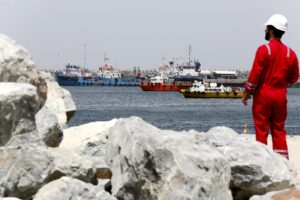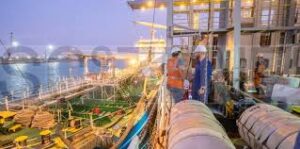Insurance Costs Surge on Red Sea Routes
Isn’t it intriguing that only the major container lines and not tankers, LNG and bulk carriers have diverted from the Red Sea routes. A Suezmax tanker with a load of 750,000 barrels priced at $80/bbls is a cargo worth around $60 million. At a war risk insurance of 0.7% that amounts to $420,000. A 10,000 container ship could have cargo worth a $1m in just a single container which calculates the net worth of a container ship at potentially a $ billion for Ultra large container vessels and at $500m cargo evaluation that is staggeringly close to $3.5m in war risk premium.
Susceptibility of Fire Caused Damage& War Risk Premium
An attack by a small sized drone or an unmanned aerial vehicle (UAV) launched by Houthi forces may cause a fire on a container vessel and LNG/LPG carriers remain at significantly higher risk of fire yet it seems that such LNG or LPG ships have successfully negotiated substantially lower war risk insurance than the publicly declared 0.7 % rate which has the inbuilt costs now of coalition force escort.Surge in insurance costs and war premium is a financial cost of maintaining US and Western Naval fleets with freight and logistic costs becoming increasingly expensive .Not to mention the additional bunkering cost for ships sailing the longer route around the Cape of Good Hope and the inconvenience of bunkering as the longer route does not have adequate bunkering hubs.
Bunkering in Gulf and Pakistan
Bunkering is strategically important in port and shipping businesses and the rapid expansion of liquified natural gas (LNG) bunkering is done by private investors and operators for LNG bunkering facilities .Yet port authorities have a crucial role in facilitating and promoting the use of LNG as a marine fuel. Competition is intensifying between two ports of United Arab Emirates (UAE) and Sohar, Oman, as bunkering hubs in the Persian Gulf and the Arabian Sea. So far Dubai is the lead bunkering performer despite Sohar’s strategic location . Dubai continues to capitalise on its economies of scale and sustainability, attractive pricing and increasing demand in LNG bunkering. International shipping lines attach value to factors of feeder connectivity, environmental issues , port portfolio, cost competitiveness and supply chain.
Fujairah versus Regional Bunkering Ports
The UAE’s Port of Fujairah, world’s third-biggest bunkering hub, is encountering increased competition to supply marine fuels in the region from Saudi Arabia , Qatar and Egypt. Fujairah has achieved the distinction of supplying 651,430 cu m of bunkering fuel in a single month and delivered LSFO touched the dizzying height of $1,003/mt in March this year . The Port of Fujairah is more expensive than Singapore in terms of spread of delivered marine fuel 0.5%. A trend is developing amongst Middle Eastern exporters to bypass Fujairah to avoid excessive port delays. Qatar has started supplying marine fuels for its own LNG fleet becoming the second-largest bunkering hub in the Middle East after Fujairah. The Port of Fujairah has fallen behind in investing in storage and supply of new alternative fuels mainly LNG despite the mounting pressure for maritime decarbonisation to meet carbon emission reduction targets set out by the International Maritime Organization (IMO) .These targets and goals include reducing carbon emissions by 40% from 2008 levels by 2030 and overall greenhouse gas (GHG) emissions by 50% by 2050.
Longer Waiting Time Irks Liners
Cargo ships docking at Kuwait, Basrah, and Khor al Zubair are encouraged by shorter lead times and competitive bunker fuel prices in Sohar, Oman and Iraq. Iran is developing the oil docks of the Shahid Rajaei strategic port in the Strait of Hormuz in the Persian Gulf in order to increase its share of the bunkering market and expand export of petro products. For any bunkering hub to develop variables of port software and hardware infrastructure, sustainable fuel supply, cost of providing services with competitive price, supply of other ancillary services, port rules and regulations and geographical advantages all have an impact on its bunkering industry. Presently Iran’s bunkering industry is not in a desirable position .
 Credit;Reuters
Credit;Reuters
The Port of Fujairah has traditionally been a significant bunkering hub for ships operating in the Persian Gulf region and evolved through the construction of tank farms, bunkering facilities and modest refineries. However congestion and wait times to bunker in Fujairah are as much as six to seven days compared with four to five days at Iraq which are compelling liners to divert its cargo ships and tankers to sail to Iraqi ports rather than Fujairah because of shorter lead times and competitive pricing. The Iraqi bunkering industry boasts of sufficient availability for gasoil, high sulfur grades with moderate availability for low sulfur fuel and barging rate up to 300 mts/hr.
Suez as Bunkering Hub
 Credit;Suez Canal Economic Zone
Credit;Suez Canal Economic Zone
Egypt has issued two bunkering licenses for the Suez Canal and two licenses on the port side for supply of bunkering service to a market that serves around 20,000 ships a year compared with 10,000 ships annually at Fujairah. Not to be outdone and as maritime rivalry exists Saudi Arabia is nursing ambitions as a major bunkering hub and establishing bunkering at Yanbu and Jeddah on the Red Sea. Perhaps on this account Saudi Aramco Trading is entering the Pakistani inland retail fuel market. Bahrain is making marine gasoil available to shippers, Djibouti is offering HSFO, Jebel Ali in Dubai is probably supplying 50,000 mt/month while the UAE’s Ras Al Khaimah is providing fuel oil and Oman’s Port of Duqm has a barge supply system. The Port of Duqm has dedicated bunkering barges with a total capacity of 5,000-tonne at the Port of Duqm in the initial stage, supplying MGO, VLSFO and marine lubes to vessels calling at the port and dedicated anchorage areas. Pakistan has a long coastline which connects its provinces yet is lacking severely in bunkering and bunkering barges and needs to develop its two ports at Karachi and at Gwadar being potential maritime and bunkering hubs rivals to regional ports. The national shipping flag carrier Pakistan National Shipping Corporation (PNSC) ships do not bunker at the ports of Pakistan and pay precious foreign exchange attributing it to non ability of Pakistan’s refineries to produce marine fuels and lube oils. In the financial year 2019-20 imports of services for transportation and travel accounted for $ 3.109 and $ 1.236 billion respectively which is a huge drain of Pakistan foreign currency reserves. The banking sector is not keen to invest in bunkering projects in Pakistan perhaps as it is earning shamefully high profits from its lending to the government . Local bunkering operators complain that while they can carry out bunkering within harbour if a ship is offshore there are severe issues involved of Customs and security clearance which may take hours and one day operating cost and demurrage of a ship typically may run into 35,000 to 40,000 USD. At times the barges have to make 2 or 3 rounds to the outer anchorage to bunker 1000 mts .There are a few bunkering barges available at Karachi which have a barging rate ranging from 100 to 500 mts/hr. Time is running out and Pakistan’s maritime policy makers have to act decisively .
Authored by Nadir Mumtaz
Credit/Citations
https://gcaptain.com/ships-bypass-fujairah-for-cheap-iraqi-bunkers/

Leave A Comment